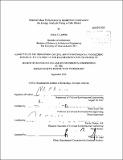| dc.contributor.advisor | Franz-Josef Ulm. | en_US |
| dc.contributor.author | Ledwith, Alison C. (Alison Catherine) | en_US |
| dc.contributor.other | Massachusetts Institute of Technology. Dept. of Civil and Environmental Engineering. | en_US |
| dc.date.accessioned | 2013-03-28T18:08:13Z | |
| dc.date.available | 2013-03-28T18:08:13Z | |
| dc.date.copyright | 2012 | en_US |
| dc.date.issued | 2012 | en_US |
| dc.identifier.uri | http://hdl.handle.net/1721.1/78146 | |
| dc.description | Thesis (S.M.)--Massachusetts Institute of Technology, Dept. of Civil and Environmental Engineering, 2012. | en_US |
| dc.description | Cataloged from PDF version of thesis. | en_US |
| dc.description | Includes bibliographical references (p. 233-241). | en_US |
| dc.description.abstract | Given the pervasiveness of energy efficiency concerns in the built environment, this research aims to answer key questions regarding the performance of thermal mass construction. The work presents the Cube Model, a simplified model of the single-family home. The model combines simplified geometry and equivalent envelope parameters with accurate climate data and internal loading assumptions. The model first addresses the notion as to whether building simplification is a valid means of analysis through a calibration and validation study. Then, the model is used to address three research areas on passive thermal mass: (1) the quantification of thermal mass performance with respect to material thermal properties; (2) the optimization of thermal mass performance for given material parameters; and (3) the sensitivity of thermal mass performance to infiltration and geometry effects. The experiments for wall and slab constructions, to address the first research area, demonstrate that the energy savings from thermal mass are both climate and season dependent. Results provide the magnitude of energy savings in fifty climates across the United States. Optimization experiments on the material thickness and conductivity, to address the second research area, show that constructions do not reach peak thermal mass performance at the same thermal properties in all climates. Sensitivity analyses, to address the third research area, indicate that passive thermal mass and tight construction practices can be mutually optimized without a trade-off of energy performance. Geometry effects demonstrate that modifications in building design can either benefit or hinder the performance of passive thermal mass. The combination of the results suggests that optimum design for thermal mass performance and the resulting energy consumption are climate-dependent and sensitive to many factors aside from material thermal properties. | en_US |
| dc.description.statementofresponsibility | by Alison C. Ledwith. | en_US |
| dc.format.extent | 241 p. | en_US |
| dc.language.iso | eng | en_US |
| dc.publisher | Massachusetts Institute of Technology | en_US |
| dc.rights | M.I.T. theses are protected by
copyright. They may be viewed from this source for any purpose, but
reproduction or distribution in any format is prohibited without written
permission. See provided URL for inquiries about permission. | en_US |
| dc.rights.uri | http://dspace.mit.edu/handle/1721.1/7582 | en_US |
| dc.subject | Civil and Environmental Engineering. | en_US |
| dc.title | Thermal mass performance in residential construction : an energy analysis using a cube model | en_US |
| dc.title.alternative | Energy analysis using a cube model | en_US |
| dc.type | Thesis | en_US |
| dc.description.degree | S.M. | en_US |
| dc.contributor.department | Massachusetts Institute of Technology. Department of Civil and Environmental Engineering | |
| dc.identifier.oclc | 829253338 | en_US |
